Introduction to Harmful Algal Blooms
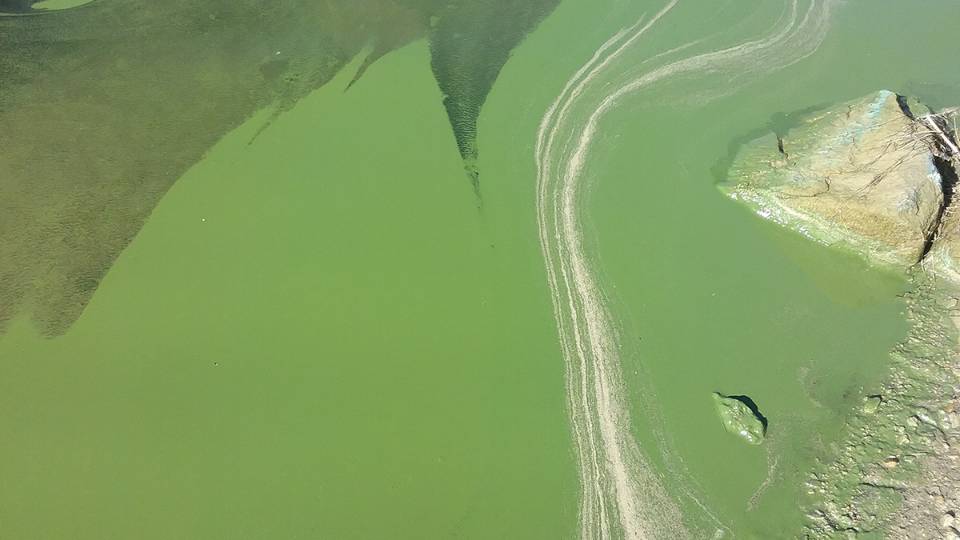
A harmful algal bloom is a phytoplankton containing toxic cyanobacteria, or cyanotoxins. Cyanobacteria have been on the earth for 3.5 billion years and have been found in all types of water bodies[1]. Even though the existence of cyanobacteria is not new, blooms have increased due to various factors, including pollution and climate change[1].
Influencing Factors
The concentration of nutrients in the water, the light intensity, and water temperature are all factors that create the perfect recipe for cyanobacteria to grow. Cyanobacteria thrive in nitrogen loaded water that is warm. The pH of water is affected by the presence of cyanobacteria, as a higher proportion of cyanobacteria causes higher photosynthesis rates[3].
| Promote Growth | Modulate Growth | Discourage Growth |
|---|---|---|
| High phosphorous | Strong biogeochemical gradients | Low phosphorous |
| Low nitrogen to phosphorous ratios | Diverse habitats | High nitrogen to phosphorous ratios |
| Low turbulence | Selective grazing | High turbulence and vertical mixing |
| Long water residence time | Short water residence time | |
| High light | Low light | |
| Warm temperatures | Cool temperatures | |
| High dissolved organic matter | Low dissolved organic matter | |
| Sufficient iron and trace metals | Low iron and trace metals | |
| Low grazing rates by mesozooplankton or fish | High grazing rates | |
| Cyanophages- viruses that infect cyanobacteria | ||
| Predatory bacteria |
Appearance
There are different types of harmful algal blooms. They generally take on an unnatural blue-green appearance, however cyanobacteria have been found in water samples where there was no visual indicator.
| Clump | 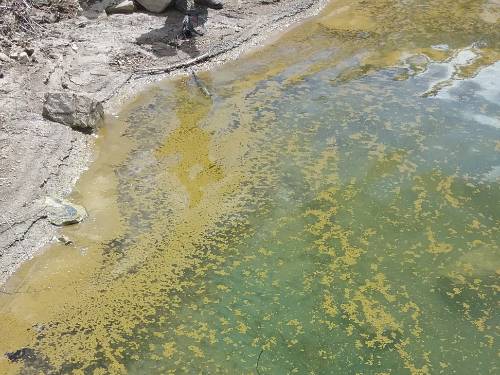 |
Green Mat |  |
| Spilled Paint | 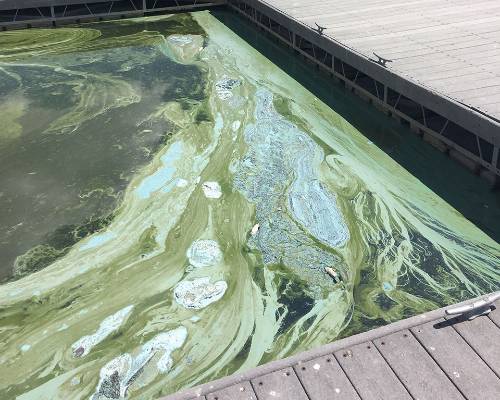 |
Pea Soup | 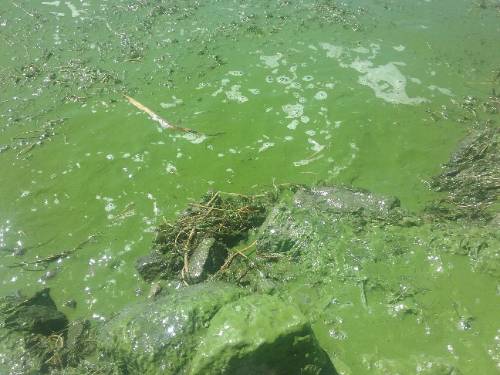 |
Methods of Exposure
There are three ways humans can be exposed to cyanotoxins – ingestion, inhalation, and skin contact. Ingestion can come about through many means. A person can ingest cyanobacterial cells from eating aquatic animals or invertebrates, eating plants grown with contaminated irrigation water, consuming contaminated water, or by taking contaminated algal supplements[1]. However, drinking water treatment system processes are efficient at eliminating cyanobacteria. Inhalation occurs when mist containing the contaminated water is breathed in, and skin contact happens when people swim in or touch contaminated water[2].
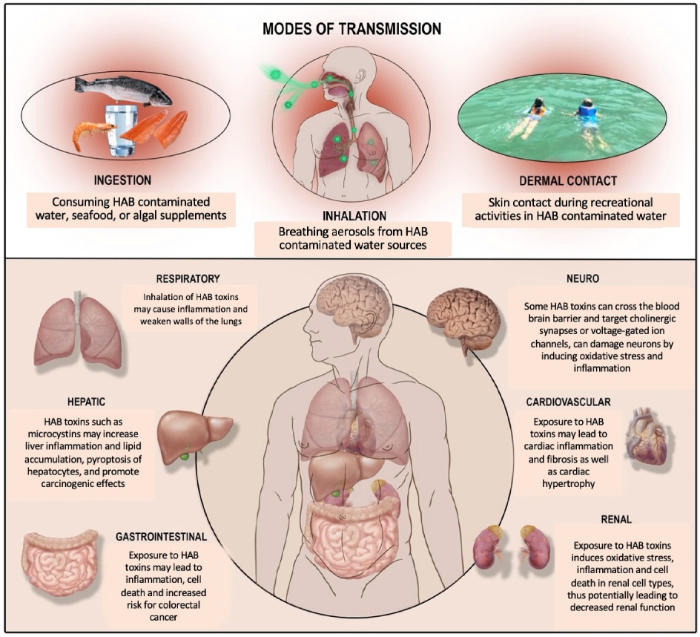
Different types of cyanobacteria have been found to cause adverse effects in humans and animals. If exposed, humans may show clinical signs of headache, vomiting, and diarrhea. More severe implications include an enlarged liver, severe kidney disease, and liver failure. If you have come in contact with a HAB, the best thing to do is to call poison control and seek medical care.
Animals and HABs
Like humans, pets and wildlife alike are adversely affected by harmful algal blooms. There are symptoms typical of animals with cyanobacteria toxicity including liver dysfunction, vomiting, respiratory failure, partial paralysis, and poor muscle control. These symptoms have been found to precede death in many cases. The animals with the most reported cases have been dogs, cattle, and birds. More rare cases include flamingos, insectivorous bats, rhinoceros, and honeybees[5].
Corrective Actions
Researchers are still looking for a favorable method of treating bodies of water with algal blooms while protecting wildlife. The best way is preventing HABs in the first place by eliminating sources of pollution and controlling the amount of nutrients entering a body of water. Secondary methods include mechanical mixing of the water, skimming the surface, using algaecides, and introducing lactic acid bacteria that degrade cyanobacteria.
References
[1] Buratti, F. M., Manganelli, M., Vichi, S., Stefanelli, M., Scardala, S., Testai, E., & Funari, E. (2017). Cyanotoxins: Producing organisms, occurrence, toxicity, mechanism of action and human health toxicological risk evaluation. Archives of Toxicology, 91(3), 1049–1130. Springer Link. https://doi.org/10.1007/s00204-016-1913-6[2] Lad, A., Breidenbach, J. D., Su, R. C., Murray, J., Kuang, R., Mascarenhas, A., Najjar, J., Patel, S., Hegde, P., Youssef, M., Breuler, J., Kleinhenz, A. L., Ault, A. P., Westrick, J. A., Modyanov, N. N., Kennedy, D. J., & Haller, S. T. (2022). As we drink and breathe: Adverse health effects of microcystins and other harmful algal bloom toxins in the liver, gut, lungs and beyond. Life, 12(3), 418. https://doi.org/10.3390/life12030418
[3] Office of Water. (2015). Health effects support document for the cyanobacterial toxin microcystins (EPA- 820R15102). Environmental Protection Agency. https://www.epa.gov/sites/default/files/2017-06/documents/microcystins-support-report-2015.pdf
[4] Roberts, V. A., Vigar, M., Backer, L., Veytsel, G. E., Hilborn, E. D., Hamelin, E. I., Vanden Esschert, K. L., Lively, J. Y., Cope, J. R., Hlavsa, M. C., & Yoder, J. S. (2020). Surveillance for harmful algal bloom events and associated human and animal illnesses - one health harmful algal bloom system, United States, 2016–2018. MMWR. Morbidity and Mortality Weekly Report, 69(50), 1889–1894. https://doi.org/10.15585/mmwr.mm6950a2
[5] Steward, I., Seawright, A. A., & Shaw, G. R. (2008). Cyanobacterial poisoning in livestock, wild mammals and birds - an overview. In H. K. Hudnell (Ed.), Cyanobacterial Harmful Algal Blooms: State of the Science and Research Needs (pp. 613–637). Springer. https://doi.org/10.1007/978-0-387-75865-7_28
Authors
Erin Rivers, Water Quality Extension Specialist; Abby Barton, Intern
Related Research





